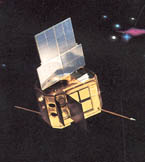|
|
The EXOSAT Observatory
 The European Space Agency's X-ray Observatory, EXOSAT, was operational from May
1983 to April 1986. During that time, EXOSAT made 1780 observations of a wide
variety of objects, including active galactic nuclei, stellar coronae,
cataclysmic variables, white dwarfs, X-ray binaries, clusters of galaxies, and
supernova remnants.
The European Space Agency's X-ray Observatory, EXOSAT, was operational from May
1983 to April 1986. During that time, EXOSAT made 1780 observations of a wide
variety of objects, including active galactic nuclei, stellar coronae,
cataclysmic variables, white dwarfs, X-ray binaries, clusters of galaxies, and
supernova remnants.
Mission Characteristics
 Lifetime :
May 26, 1983 - April 9, 1986 Lifetime :
May 26, 1983 - April 9, 1986
 Energy Range : 0.05-50 keV
Energy Range : 0.05-50 keV
 Special Features : 90 Hours highly-eccentric Earth orbit
Special Features : 90 Hours highly-eccentric Earth orbit
 Payload :
Payload :
- 2 Wolter Type I grazing incidence Low Energy (LE; 0.05-2 keV) Imaging Telescopes, FOV ~ 2°, peak effective area 10 cm2 each with
- Channel Multiplier Array (CMA; 0.05-2.0keV)
eff. area 0.4 - 10 cm2, FOV ~2°, ~18 arcsecond spatial resolution
- Position Sensitive Detector (PSD)
- Transmission Gratings (TGS)
500 lines mm-1(LE2), 1000 lines mm-1(LE1). Used
in conjunction with the CMA detectors.
- A Medium Energy (ME) Proportional Counter
1-50 keV, FOV 45 arcmin, 1600 cm2
- A Gas Scintillation (GS) Proportional Counter
2-20 keV, 100 cm2
 Science Highlights:
Science Highlights:
- Discovery of the Quasi Period Oscillations in LMXRB and X-ray Pulsars
- Comprehensive study of AGN variability
- Observing LMXRB and CV over many orbital periods
- Measuring iron line in galactic and extra galactic sources
- Obtaining low-energy high-resolution spectra
 Archive :
HEASARC hosts catalogs, spectra, lightcurves, images and raw data
Archive :
HEASARC hosts catalogs, spectra, lightcurves, images and raw data
[EXOSAT Home]
[About EXOSAT]
[Archive]
[Software]
[Gallery]
[Publications]
[All Missions]
[by Time]
[by Energy]
Page authors: Lorella Angelini Jesse Allen
HEASARC Home |
Observatories |
Archive |
Calibration |
Software |
Tools |
Students/Teachers/Public
Last modified: Thursday, 24-Sep-2020 19:09:56 EDT
|
 The European Space Agency's X-ray Observatory, EXOSAT, was operational from May
1983 to April 1986. During that time, EXOSAT made 1780 observations of a wide
variety of objects, including active galactic nuclei, stellar coronae,
cataclysmic variables, white dwarfs, X-ray binaries, clusters of galaxies, and
supernova remnants.
The European Space Agency's X-ray Observatory, EXOSAT, was operational from May
1983 to April 1986. During that time, EXOSAT made 1780 observations of a wide
variety of objects, including active galactic nuclei, stellar coronae,
cataclysmic variables, white dwarfs, X-ray binaries, clusters of galaxies, and
supernova remnants.

